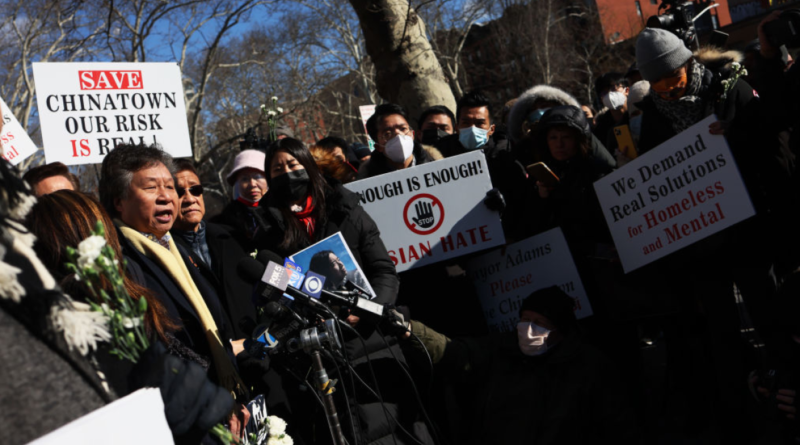The new mega jail coming to NYC’s Chinatown is a physical reminder of anti-Asian hate
Protesters and organizers have emphasized that the Chinatown mega jail would harm the local residents and those held within its walls.
It was a gray day in New York City’s Chinatown on March 20 when a large group of protesters gathered at the southern tip of Columbus Park. Approximately 2,000 protesters were in attendance, united around a common goal: resisting the world’s tallest mega jail. Led by Neighborhoods United Below Canal, protesters marched in opposition to the demolition of the Manhattan Detention Center prison in Chinatown, commonly known as “the Tombs,” for a new one. Construction on the new $8.3 billion 40-story jail is projected to last until at least 2027.
The sale of the Tombs was signed under former mayor Bill de Blasio in 2017 and remains intact under Mayor Eric Adams as part of the pact to close Rikers Island and build other “humane” jails in all boroughs except the majority white and conservative Staten Island.
At the Chinatown rally, Grace Lee, a candidate for New York State Assembly, cited in her speech environmental concerns with demolition, emphasizing the release of asbestos.
“Don’t the people of Chinatown have a right to breathe clean air and live in safe places?” she asked.
With the new jail, the government and its leaders are proving that they never will uphold the dignity nor affirm the humanity of Asian Americans. Opponents of the new jail’s construction have pointed out that it will have a negative impact on small businesses, particularly restaurants, which have already been affected by the pandemic and the rise in anti-Asian hate and racism. The jail’s construction noise will also severely impact the health and wellness of the elderly living in the senior center nearby. At a lunar new year parade this year, Adams said that he would speak to concerned locals about the construction of the facility. However, what Adams has yet to understand is that Chinatown belongs not only to Chinese residents but also to the Chinese folks who have been displaced by gentrification. For many of the protesters, prisons are a physical reminder of how policing has historically been used as a form of anti-Asian hate and oppression.
Chinatown has long resisted the carceral system, and much of that history is documented by Chinese-American photographer Corky Lee. In April 1975, law enforcement beat a Chinese-American man named Peter Yew for interfering in a minor traffic incident. He was taken to the precinct, stripped, beaten again, then charged with resisting arrest and assaulting a police officer. In response, Chinatown businesses closed on May 19 with signs reading “Closed To Protest Police Brutality,” and 15,000 people marched on city hall demanding justice. Shortly after, Yew’s charges were dropped. In 1982, Mayor Ed Koch introduced a $101 million plan to build a new jail. This involved the displacement of residents through selling buildings and giving each tenant only $250 to relocate. An estimated 12,000 protestors rallied and blocked entry to the Brooklyn Bridge, ultimately deterring the new jail’s construction.
Currently, the prison system remains a deep threat to Asian Americans. In the Trump administration’s first year, ICE increased its deportation efforts by 150%. In the 2018 fiscal year, most of the deportees in New York City were Chinese, followed by Indian immigrants. Before ICE was even established, the incarceration of Asian Americans increased by 250% in the 1990s alone. Since 1998, at least 15,000 Lao, Cambodian, and Vietnamese incarcerated immigrants and refugees have received deportation notices—and 80% of those were given based on previous records, not current offenses. This prison-to-deportation pipeline is distinctly anti-Asian.
In the struggle against policing and incarceration, many New York-based Asian American organizing groups like Red Canary Song uplift tragic examples of police overreach and violence. Many remember Yang Song, a Chinese immigrant woman who worked in a spa in Flushing, Queens. Shortly after she confided to her mother that she reported being sexually assaulted by an undercover police officer in 2017, NYPD officers raided Song’s place of work, and she fell four stories to her death. Others would name Angelo Quinto, who died after a mental health crisis in 2020 when police put a knee to his neck in an incident hauntingly similar to the murder of George Floyd. Some people also remember Christian Hall, who was shot by police last year while experiencing a mental health crisis. Detailed footage of the police shooting has yet to be released to the public.
True safety for our AAPI communities means the abolition of prisons and policing everywhere. Jails do not belong in our communities. I don’t want prisons for human beings. I want a center for healing, for restorative justice. There is no such thing as the humane caging of human beings, not when the Thirteenth Amendment subjugates people to involuntary servitude.
Chinatown is also one of the few places I can access the culture of two of my great grandfathers, one to Jamaica and the other to the U.S. as a Paper Son during the Chinese Exclusion Act. It is where at a separate Lunar New Year celebration, an elderly woman—a complete stranger—held my hand for a few seconds as we watched the lion dances together. I may not live there, but Chinatown is a home for me, and to see it under systemic racist attacks and policing is simply shameful.
Related
ROHAN ZHOU-LEE
Rohan Zhou-Lee (They/Siya/祂 (Tā)), is a dancer, writer, trumpeter, and founder of the Blasian March, a solidarity movement for Black, Asian and Blasian communities through education on parallel struggles

